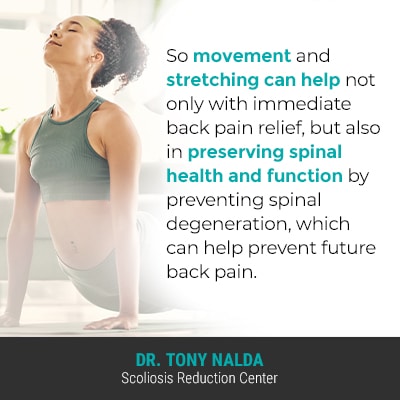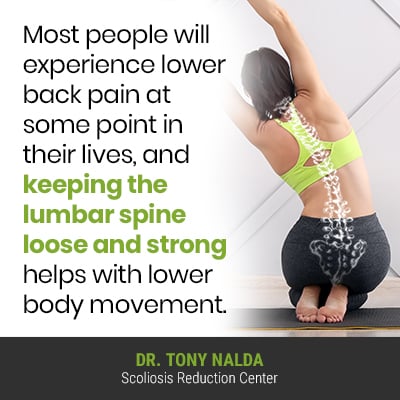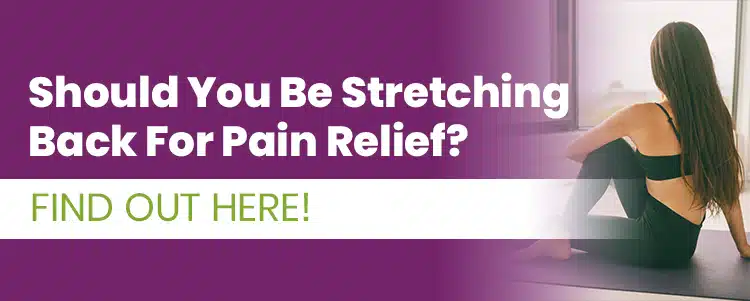Most people have struggled with back pain at some point in their lives, and depending on cause, patient age, and a number of other factors, back pain can range from mild and intermittent to chronic and debilitating. As back pain is such a common complaint, awareness of how to respond is important, and this can involve gentle stretching for pain relief.
While some cases of back pain caused by overuse injuries and strain will require rest and activity modification, in general, staying active with low-impact movement is key. The spine’s natural design is based on movement, and regular exercise and stretching can help prevent spinal degeneration: a leading cause of back pain.
No one wants to experience pain, but it serves a vital purpose: it tells us something is wrong. So let’s start with some common causes of back pain.
Aging and Spinal Degeneration
The body degenerates with age, and the spine is no exception; while there is a certain amount of spinal degeneration to be expected with age, a number of factors shape a person’s level and rate of age-related changes to spinal health and function.
So what happens to the spine as we age, and how does it cause pain?

The spine has three main sections: the cervical spine (neck), the thoracic spine (middle/upper back), and the lumbar spine (lower back).
The health of each section is dependant on the health of the others, and each spinal section consists of vertebrae (bones of the spine) stacked on top of one another in a straight and neutral alignment, and adjacent vertebral bodies are separated by an intervertebral disc.
Each spinal section is curved, and if the spine’s natural and healthy curves are in place, it’s going to be stronger, more flexible, and better able to handle mechanical stress incurred during activity; there are a number of spinal conditions that involve a loss of the spine’s healthy curves, and this can also cause compression and back pain.
As the spine degenerates, this is a leading cause for back pain, and in most cases of spinal degeneration, it’s the intervertebral discs that are the first spinal structures to deteriorate, and this can involve disc desiccation, a bulging, and/or disc herniation.
The discs are the largest structures inside the body that don’t have their own vascular supply, which is part of why they commonly degenerate first, and one thing that helps preserve the health of the discs is regular movement as this can help keep the discs hydrated by increasing circulation: making nutrients needed for repair and restoration more accessible to the discs through osmosis.
So movement and stretching can help not only with immediate back pain relief, but also in preserving spinal health and function by preventing spinal degeneration, which can help prevent future back pain.
Back Pain
At some point in life, it’s said that everyone will deal with a degree of back pain; lower back pain is the most common, and this is because the lumbar spine has to support the weight of the spinal sections above, the entire trunk, and the lumbar vertebrae feel the effects of bending, lifting, and twisting motions.
Back pain can involve localized pain in and around the spine, the spine’s surrounding muscles, and also the spine’s surrounding nerves.
The spine contains 31 pairs of spinal nerves within, making up the spinal cord, which works in tandem with the brain to form the body’s central nervous system, and this is where nerve-related back pain is relevant.
When a nerve in the spine is exposed to uneven pressure either inside the spinal cord, or at its root, where it exits the spine, nerve compression can cause pain felt anywhere along an affected nerve’s pathway, which can be extensive.
Nerve are like branches of a tree, fanning off in multiple directions, so pain can be felt far from its source of nerve compression, and pinched nerves in the back often cause pain that radiates into the extremities.
It’s said that nerve-related back pain is the most debilitating form, and while irritated nerves don’t always like to be stretched, keeping the spine and its surrounding muscles strong and flexible can help with pain relief and prevention.
Stretches for Back Pain Relief
The best approach to back pain is leading a spine-friendly lifestyle, and this includes maintaining a healthy activity level and incorporating regular stretching exercises into daily routines.
Regular stretching can help keep the spine loose, flexible, and strong, and it can also help keep the spine’s supportive muscles loose, flexible, and strong, and strong core muscles means a spine that’s receiving optimal support and stabilization.
It is important, however, to understand that if a spinal injury or condition is the underlying cause of back pain, for long-term sustainable pain relief, the injury or condition has to be proactively addressed; in these types of cases, back pain is only a symptom of a larger issue.
For general back pain, however, regular stretching can help in a number of ways: by stretching tight muscles, increasing spinal strength and flexibility, and helping to keep the spinal discs hydrated and healthy.
Stretch recommendations will also be specific to each section of the spine so we’ll start with stretches for the cervical spine that can help with neck and/or shoulder pain.
Stretches for Neck Pain
The cervical spine has to support the weight of the neck, the head, and facilitate the neck’s range of motion.
Poor posture caused by looking down at devices for long periods of time in the modern age has led to a lot of cervical spine issues, and when the neck is becoming painful, the following stretches can help relieve pain.
Chin-to-Chest Flexion Stretch: gently bring the head forward and bend the chin toward the chest until a deep stretch is felt in the neck.
Levator Scapula Stretch: while resting one arm against a wall with the elbow held slightly above shoulder level, turn the head in the opposite direction and bring the chin down toward the collarbone until a stretch is felt in the back of the neck.
Stretches for Middle/Upper Back Pain
The thoracic spine refers to the middle/upper back and its the largest spinal section so is vulnerable to a number of issues and conditions.
Stretching can help keep the thoracic spine stable, mobile, and pain free.
Standing Thoracic Rotation Mobilization: start in a standing semi-squat position with one arm placed between the thighs just above the knees to stop unwanted hip/pelvic movement, slowly rotate the body upwards as the open arm is raised above the head and stretched towards the sky, then perform with the opposite arm.

Thoracic Spine Mobilization Bench Stretch: ideal for stretching the lattisimus dorsi muscle, the stretch starts with kneeling in front of a bench and placing the elbows on the bench while holding a straight object with both hands and palms facing up.
Sit back while pushing the buttocks towards the heels while keeping the spine loose and relaxed until a stretch is felt in the middle/upper back.
Stretches for Lower Back Pain
Most people will experience lower back pain at some point in their lives, and keeping the lumbar spine loose and strong helps with lower body movement.
Back Flexion Stretch: lie on your back and with both knees bent, pull them simultaneously toward the chest while flexing the head forward; a stretch should be felt in the lower and middle back.
Knee to Chest Stretch: while lying on the back with the knees bent, keep both heels on the floor while placing both hands behind one knee and puling it toward your chest to stretch the gluteus and piriformis muscles in the buttock.
Conclusion
So should you be staying active to prevent back pain: yes! Should you be stretching to prevent back pain: yes! Should you be stretching to ease back pain: yes!
Leading a spine-friendly lifestyle doesn’t just help ease and prevent back pain, it can also prevent injury, spinal degeneration, and a number of spinal conditions from developing.
When a spinal condition like scoliosis is the cause of back pain, however, the underlying condition has to be the focus of treatment, and this can involve chiropractic care, physical therapy, scoliosis-specific exercises, corrective bracing, and rehabilitation.
In fact, in a number of spinal conditions that involve a loss of the spine’s healthy curves, exercising and stretching is a key facet of treatment; after all, it’s not just the spine that has to maintain its natural curves and alignment, but also the spine’s surrounding muscles that have to provide spinal support and stabilization.
So stretching doesn’t just target the spine, but can also help by keeping the spine’s supportive muscles strong and healthy.
Stretching can help relieve tension on the spine, alleviate tightness in its surrounding muscles and nerves, and strengthening back and abdominal muscles can help with upper, middle, and lower back pain.
There are also a number of yoga poses that can help with back pain and keeping the back muscles strong, and yoga also encourages healthy posture and the ability to breathe deeply and regularly during exercise.
The benefits of a comfortable stretch in the back can’t be underestimated, but I do want to be clear, however, that if back pain is related to an underlying injury or spinal condition, stretching for pain relief can help relieve tension but won’t achieve corrective results; proactive treatment plans shaped around the underlying cause of back pain is the only way to achieve long-term sustainable pain relief.




